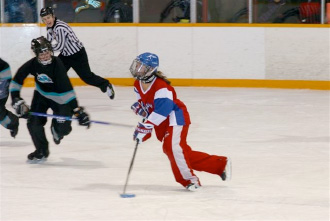To successfully get the ring out of your own end, your two defenders and center need to work as a unit.
Good defensive support can be the difference between getting a scoring chance or losing the ring deep in your own end.
“Support Your Cohort”
“Support your cohort” is what you do as the non-ring carrying defender or centre to help the ring carrier get out of trouble.
A support pass is not necessarily one that moves your team closer to the other team’s net right away. Rather, it is a pass that gets the ring carrier out of trouble so the new ring carrier can make the good break-out pass.
What is good support?
Good support is:
- Close
- On a “goal side” angle
- In a safe position
Check out these excellent keys for mastering defensive support so you can transition out of your end like a pro:
1) Close: Sometimes defenders make the mistake of getting open for their D partner but ending up all the way across the ice. If the ring carrier is being pressured deep in one corner, a wide open D partner does her no good if she’s all the way in the opposite corner of the ice. This doesn’t work because the ring carrier cannot get the ring to the supporting defender, even if she is unmarked.

- Note: Athletes will sometimes get into trouble because their support is “too close”.
Depending on the situation, a support pass to an athlete who is only 4 feet away may do more harm than good. If the checkers are on top of the ring carrier as soon as she stabs the support pass, the pass didn’t accomplish anything. “Ideal” support, then is likely 7 – 12 feet away from the ring carrier.

2) On a “goal side” angle: Supporting “square” means supporting directly parallel across the ice. This is dangerous because it makes the pass much easier for the other team to intercept. If the pass does get intercepted, there is no one back to prevent a breakaway.

That’s why you should train your athletes to support on an angle (and goal side). In general, the non ring carrying defender should be slightly closer to your own team’s net than the ring carrier.

(The exception to this is when the ring carrier is right up against the end boards in your own team’s zone. In this scenario, it is impossible for the other defender to be “behind” the ring carrier.)
3) In a safe position: Your team could be in trouble if the support pass is made right in front of your own team’s net or right across the front of your team’s net.


To ensure this doesn’t happen, your ring carrier must make smart pass choices. Also, the supporting players must make good decisions about where they position themselves on the ice.
Typically, the best support options are either across the ice behind the net or up the boards near the ringette line.


Let us know what you think.
Your friends,
Lisa Brown, Laura Warner, and Abbey Van Roekel




Great website ladies! Have become the assistant coach for U16A team and love reading/watching your tips, drills, etc. Thanks very much for being an invaluable resource!
Been a player all my life. Coaching U9. For breakout, what do you think best play for F’are:
staggered, so one at free play line-playing across if ring comes out, and one high (not too high for slow skaters at this age)or both F’s in extended zone, breaking over blue to open ice for pass? Thanks